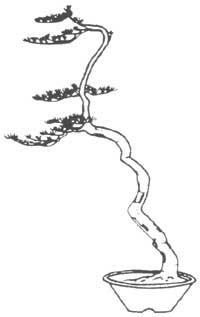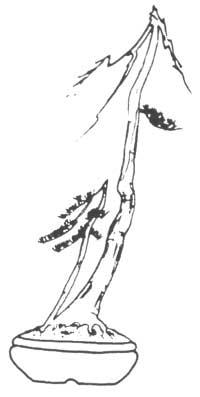Bunjin; Free style

Many believe that bonsai is only a special type of tree brought from Japan. A mistake. Any tree can become bonsai, not only in trees, but in certain types of plants: roses, barks, etc. Therefore, all art consists in reducing the size of the trees, that is, in getting the shape of the tree, without letting it grow.
It is evident that the one-year plant is small, but being away from the appearance of the adult tree, it cannot be considered a bonsai. But yes for the beginning of what will be. According to experts, the meaning of bonsai must be sought in the desire to dominate nature, whose way of expressing this dependence is based on directing the power of nature along the path desired by man.

This process would be incomplete if man received the rejection of nature (that is, if the bushes could not live this way) and in practice that problem can be overcome, so that relationship of dependence is fully realized. It is worth noting the importance that in Eastern philosophy things have reduced in size (miniatures, so to speak). The small out of norm is wrapped in mystery and magic. This is the most representative feature of bonsai: its magic.
Leaving aside the philosophical foundations, it is essential to mention the imposing technique associated with bonsai. Obtaining a raised tree within Japanese standards requires great efforts and preparations. The technique includes the smallest detail.

For example, the container holding the tree cannot be of any size or shape, as the dimensions of the tree and container are closely related. It is not the same as a tree is placed in a rectangular container or in a circle, since one gives more importance to an angle or part of the tree. However, the other equally treats all parts or views of the tree, so it demands other characteristics to its appearance. And so on: length, shape and arrangement of the branches; with the thickness of the trunk; with the form of accepting the trunk; with the apparent roots, the size of the leaves and other thousands of details.
The truth is that after reading several books by different authors about bonsai, I think that the one who wants to start in this art is quite scared. And even more if you dare to approach some exhibition. It is usually quite sad to remember the “bonsai project” that you have in the window of your house in a pot painted with red enamels, while you see real works. Anyone who wants to avoid it can buy a treated tree, but the prices are not cheap and can easily deceive the unknown. The beginning is not easy.

However, there is a solution for those who feel violated by all these rules and laws: Special BUNJIN style.
This style does not obey any concrete law, it is what commands the interior of oneself, but it is all within a harmony, because it is not the same to give freedom and appearance to what you carry inside to do any kind of narration. Obviously, this style, almost unknown, is closely linked to a very different philosophy, from which it can be understood that what within the classical style could be offended now is acceptable.
However, it is necessary to master some technical areas, even if it moves outside some laws of classical bonsai; in short, it is necessary to make the tree follow its idea. And that's the key. Pruning, transfers, wires, fertilizers, waterings, etc. are aspects to dominate well in any style, to what comes with time, the rest is marked by its nature.

Some of the models that can be framed within the BUNJIN style, collected by master John Yoshio Naka, are briefly analyzed below.
This tree was not tried to grow this way, but it was the only option to live. His philosophy and form are similar to that known as “Dharma.” Therefore, it is entitled DHARMA.
It's like a strong brush stroke. It is impossible for the trunk to regain balance, but an opposite wind turns the branches and trunk into slender.
Shredding all the rules, but it is full of personality. On the trunk, with an angle of 90º, the branch that crosses it, with branches arranged as radii and arranged in cross. However, this ancient pine still remains on Mount Txitxibu in Japan.
Birds singing joyful rhythms. It is not necessary to understand its meaning. Fragile rhythm lines in the trunk. No reason, no meaning, only pleasant.

In a wind-stirred style, the mind predicts the cause and direction of the wind that is forced by the distortion of normal models of branch growth.
IKARI-JIN or BUNJIN, double trunk or double trunk. The absence of leaves from the highest trunk underlines the BUNJIN style.
A more attractive balance, especially for the branch hanging with such bold verticality.
“One rainy day, from the top of the mountain “HIEI”, looking towards the lake “BIWAKO”, the whole landscape was covered with mists. Suddenly, the ancient eastern landscape (SUMIE) became a reality and a bat, as throughout the fog the landscape pines were bunjin style.
As in the beginning of the bonsai world, starting from the “CHOKKAN” and ending with the unfinished “BUNJIN”, there are the multiple forms of the trees of nature”.

- Collection of shrubs
- When: something before you start explaining new sheets. In our territory, towards February-March
- How to: Remove the surrounding soil from the tree while maintaining the basic roots (if they are too long, the wound resulting from the felling must be rectified downwards). Breaking the finest roots is hardly important. If the tree has scarce and strong roots, they will be injured to get hooked. Removal of roots and branches.
- Change (and transformations)
- How to: The container in which the tree is to be located is perforated at its bottom and covered with mesh or flat stone. Then fill the bottom of the container with a layer of 4 or 5 mm of fine stones. Once the soil is placed, the tree is placed as desired, extending the roots well into the container. Finally, the roots are covered with more soil, without leaving air bags, (the deposition of some root is elegant) and watered. Once the change is made, it is convenient to keep the tree in the shade for a few days.
- Land mixtures: The most basic consists of three types of land: Black earth or organic matter, clay and sand or sand. Proportions are a function of the type of tree and its age. It is usually best to go to the tables of a specialized book.
- Irrigation: Fixed irrigation rules cannot be dictated. Review the state of the tree in each period. It is clear that in summer you have to water more often, for example.
- Subscriber: There are many fertilizers on the market: soluble in water, liquids presented in bags, ... As for its use is made in spring and summer. However, its inappropriate or disproportionate use may have negative consequences. The unsubscribed tree will NOT damage the tree, but the excessive subscriber will.
- Pruning: Prune before flowering the tree with the saw or the appropriate appliances. In large cuts the cone wound is left to accelerate healing from the end.
- Blade cutting: It is done to reduce the size. They are cut by the stem of leaves, without leaving traces of leaves.





